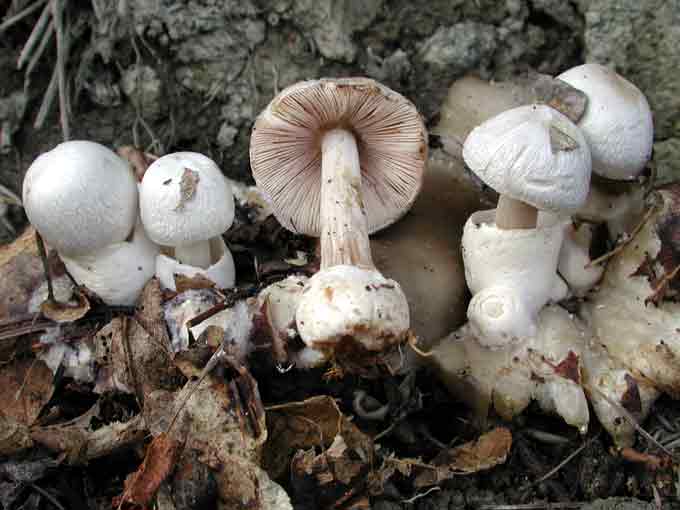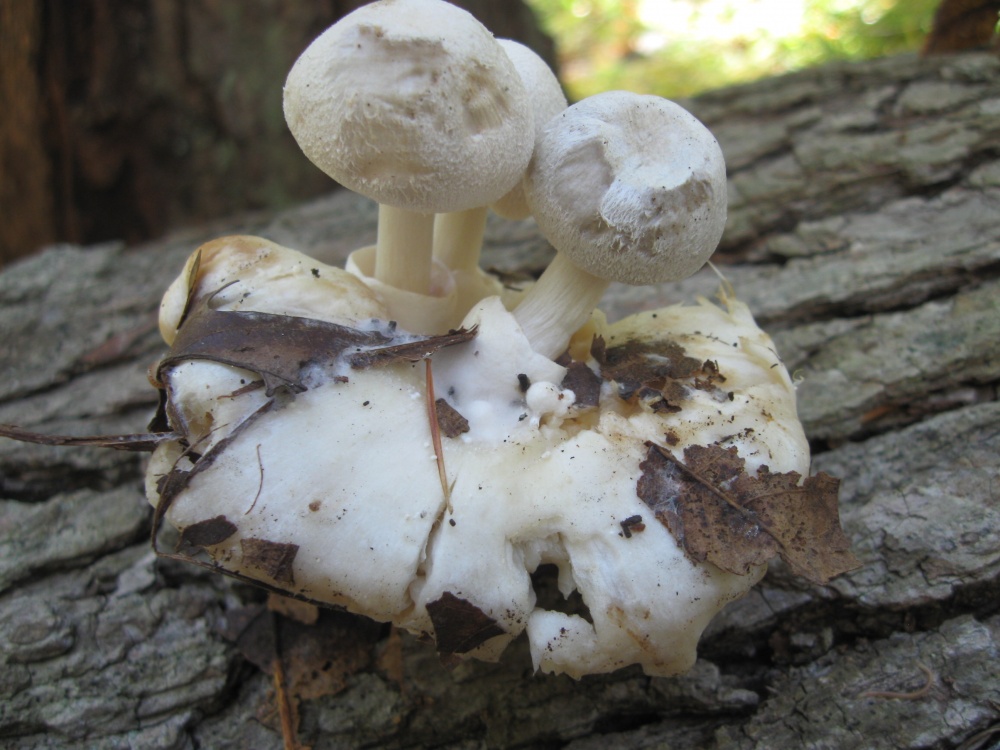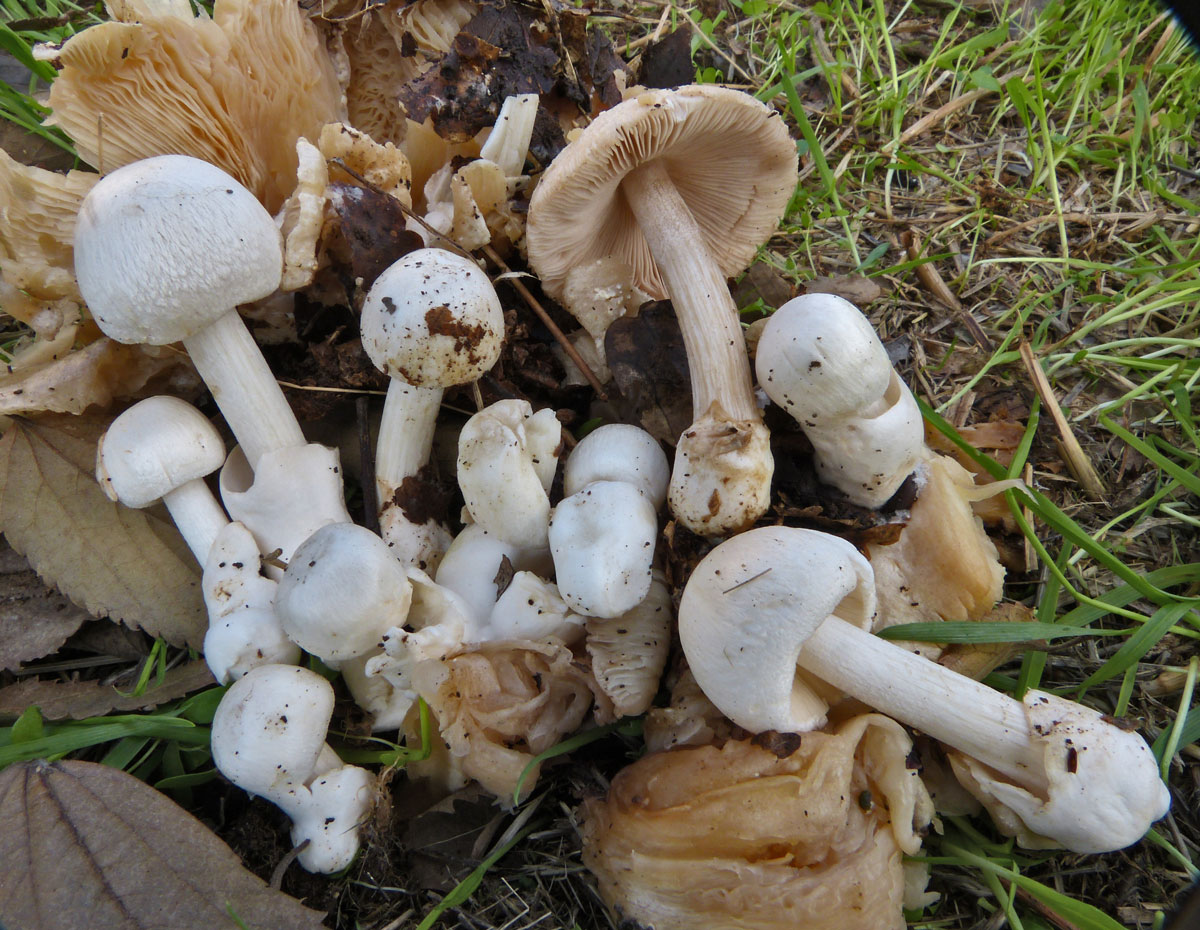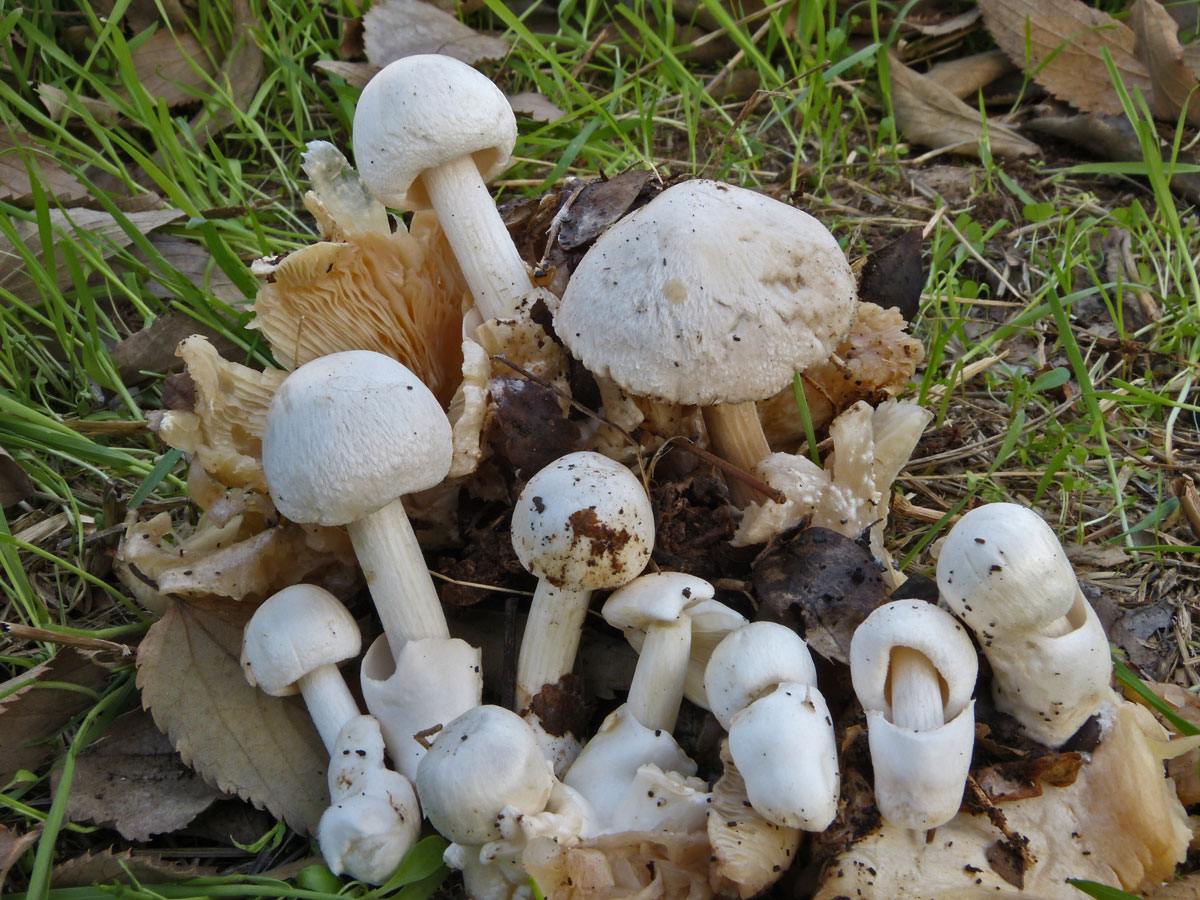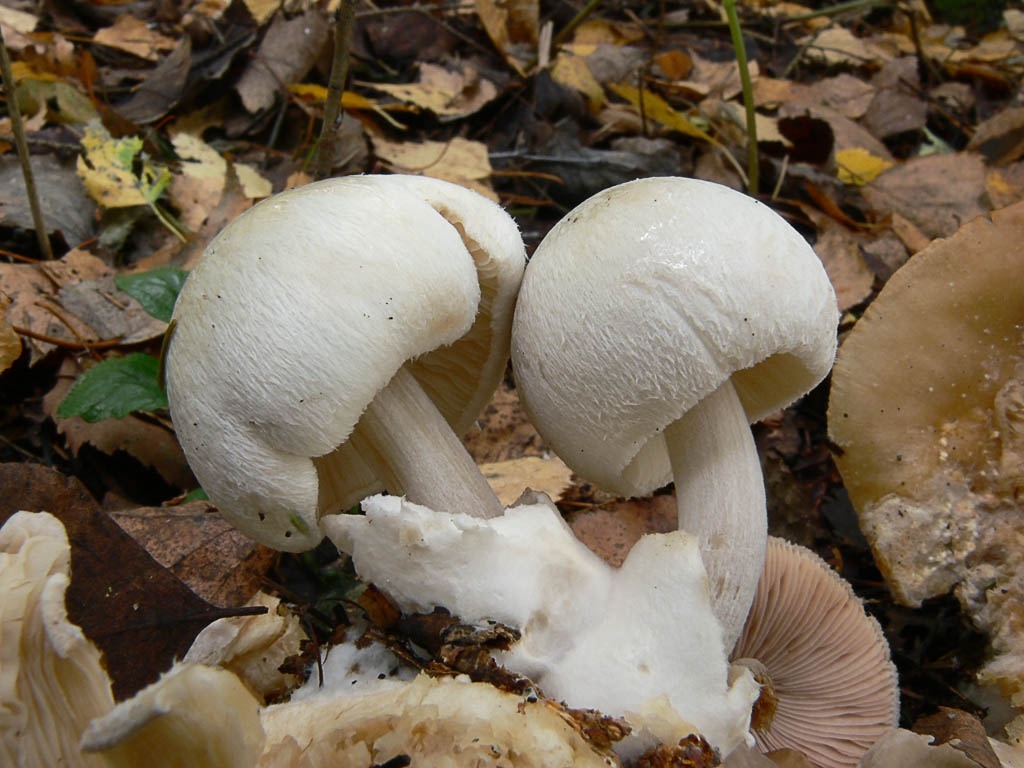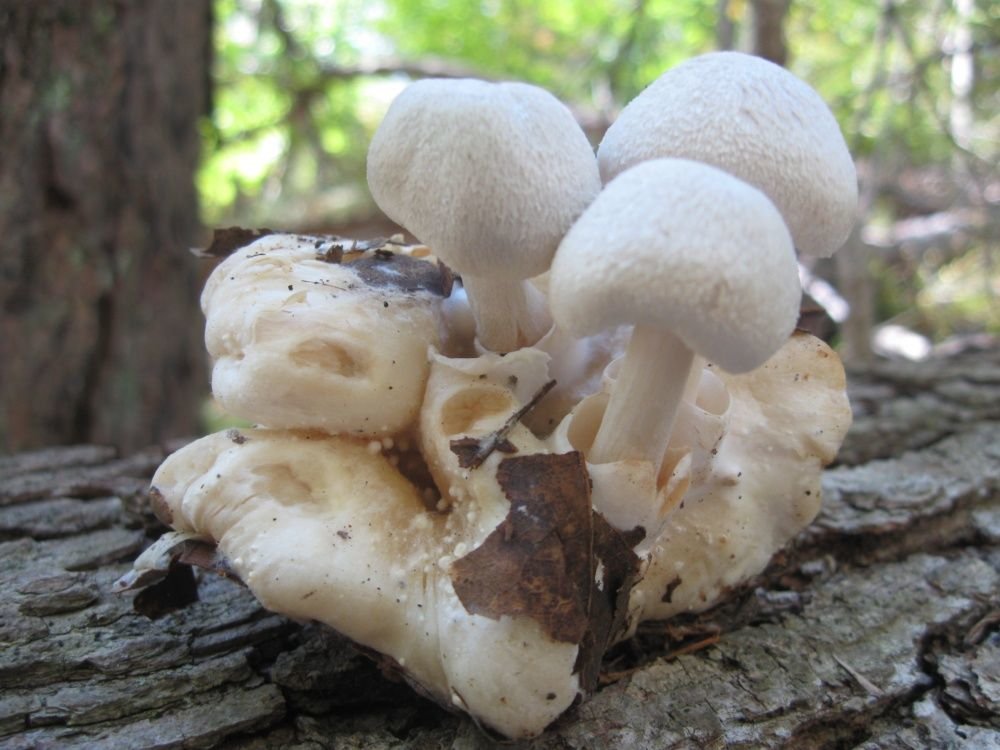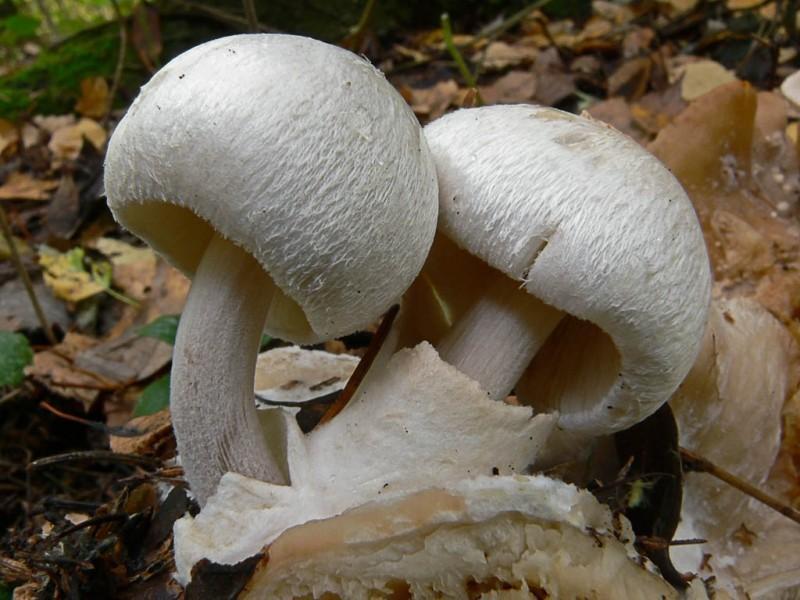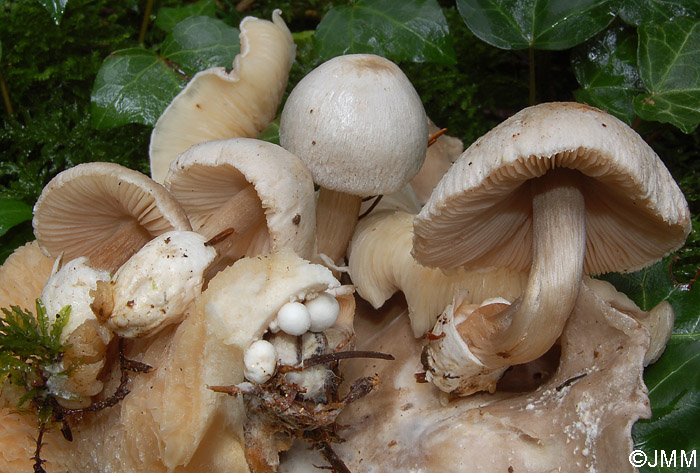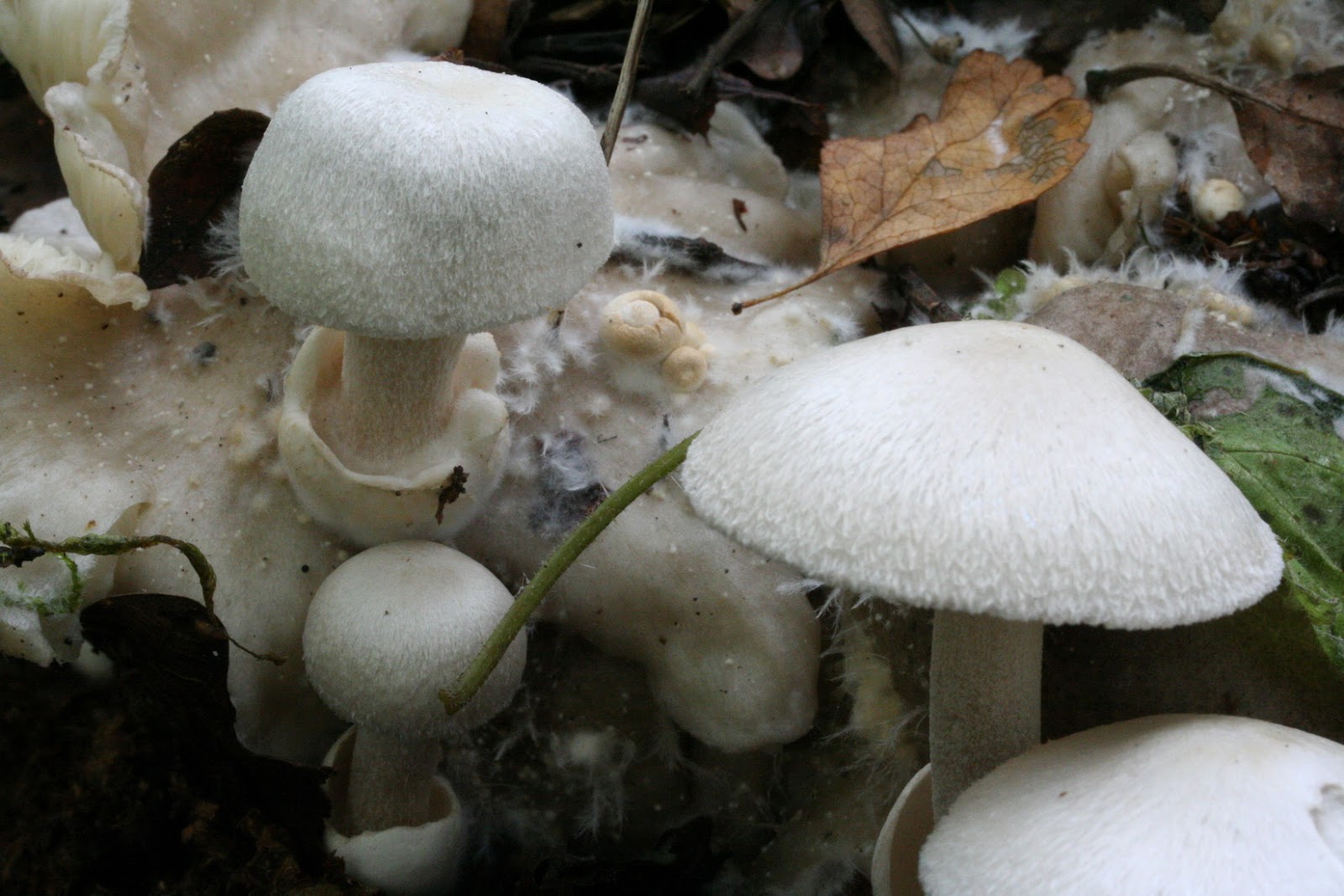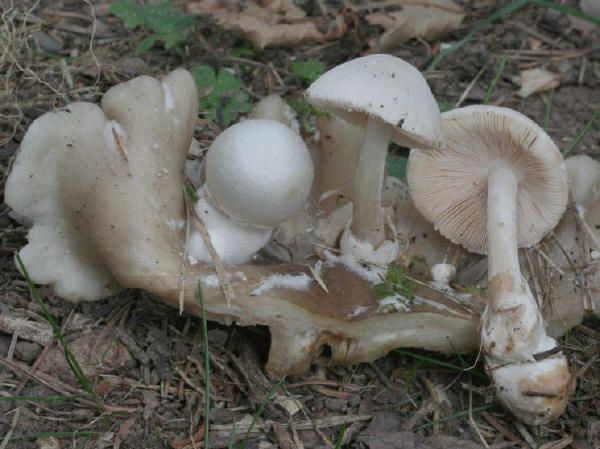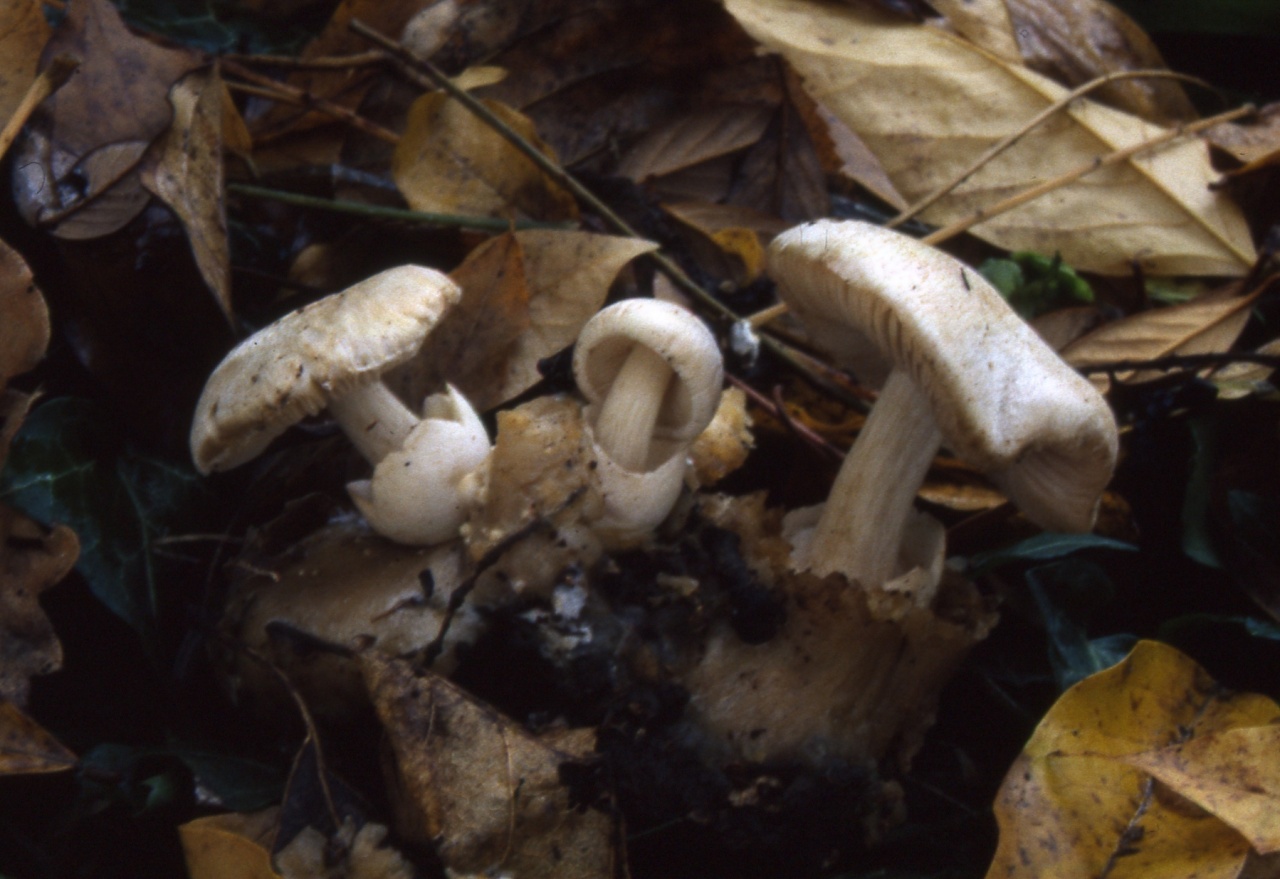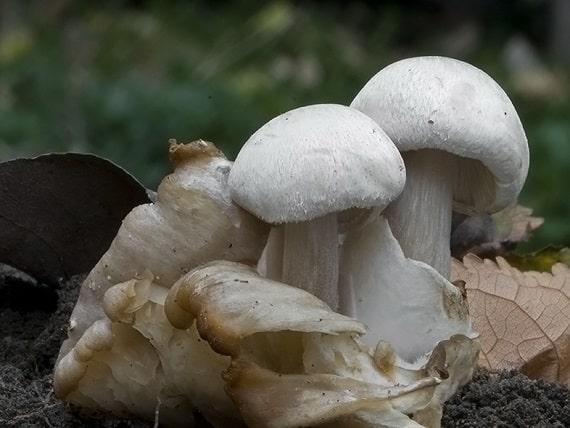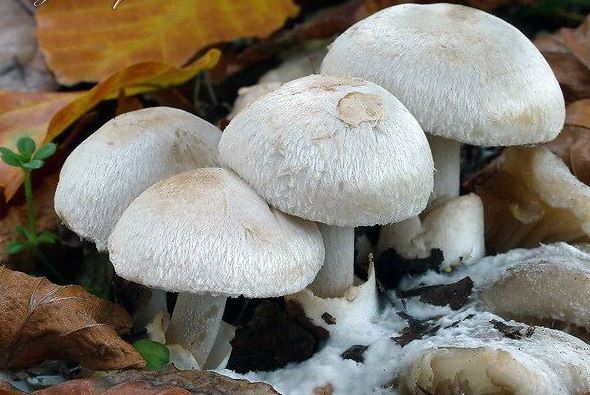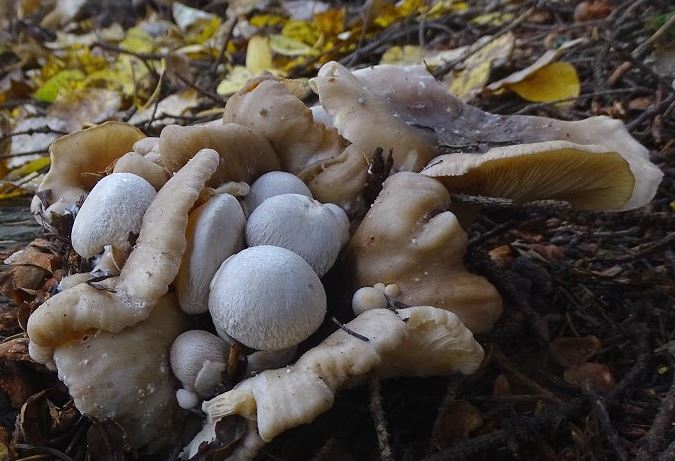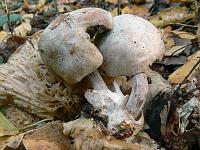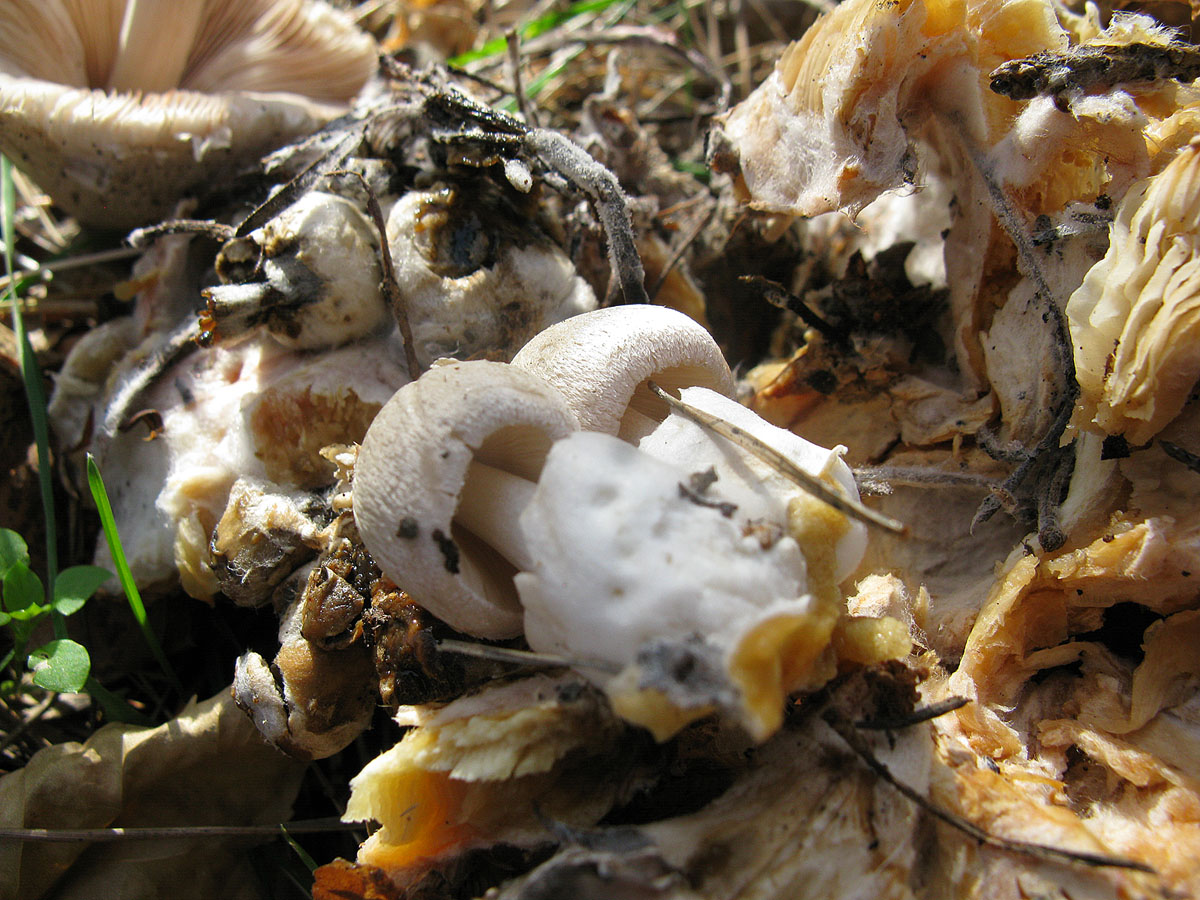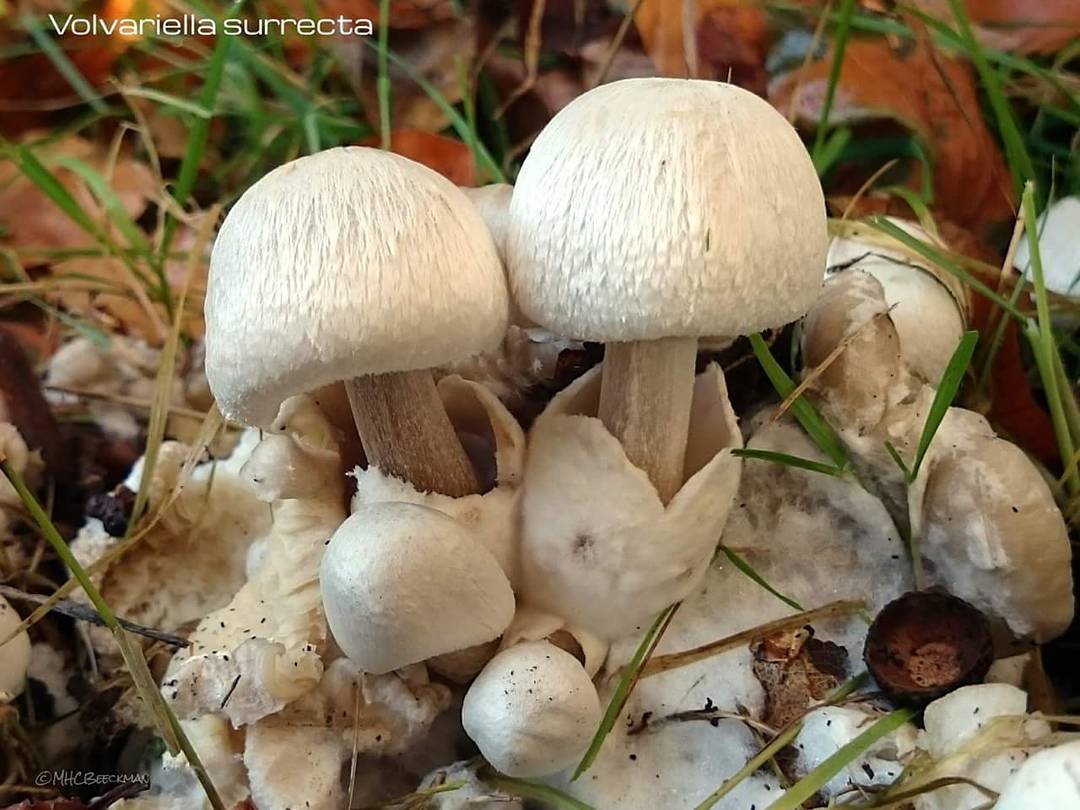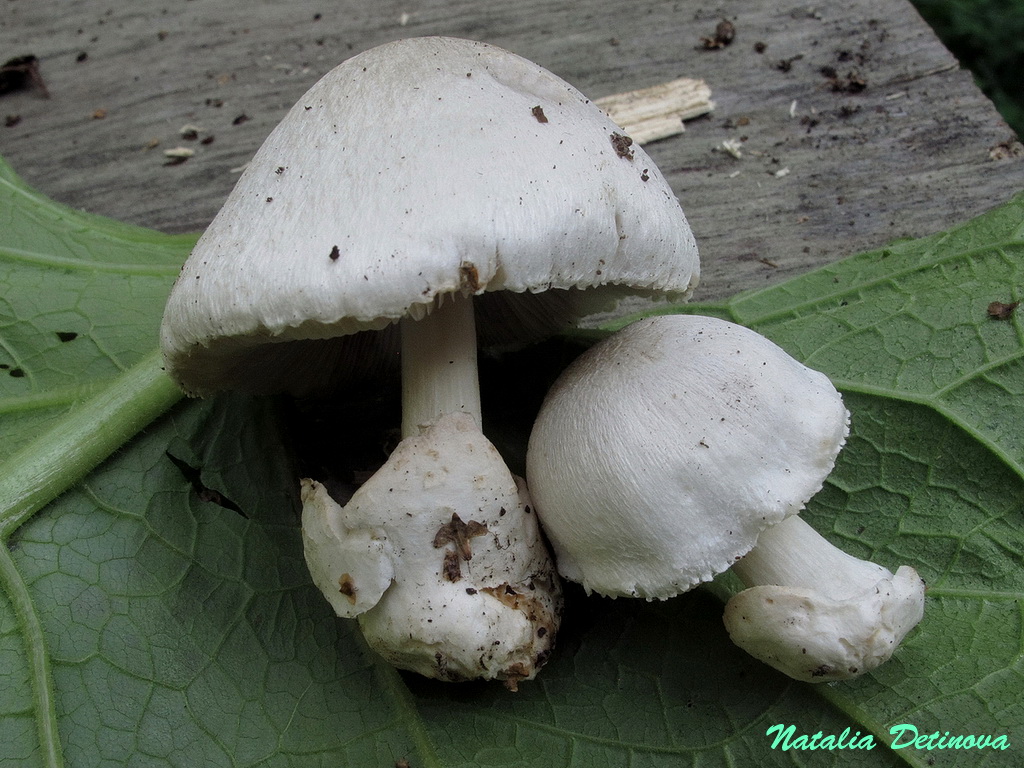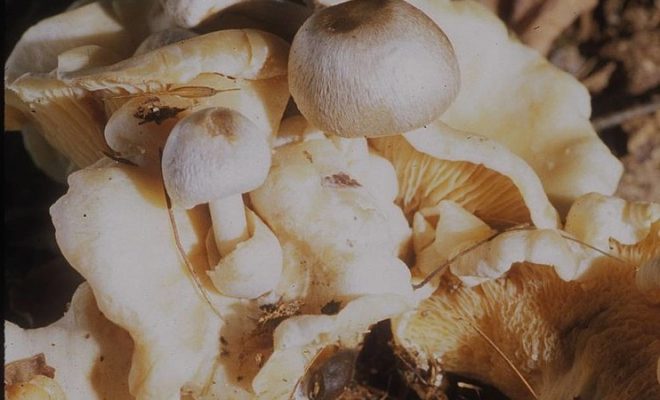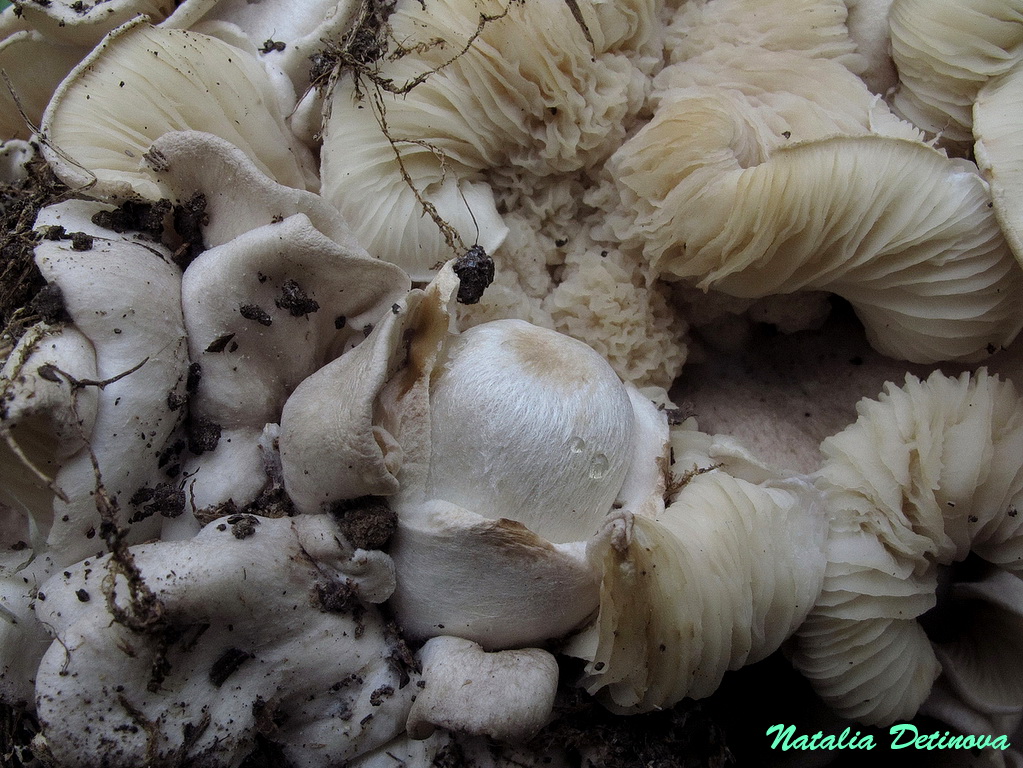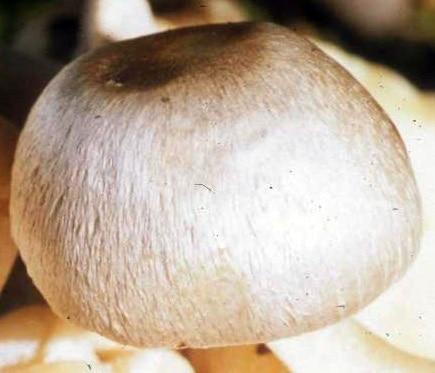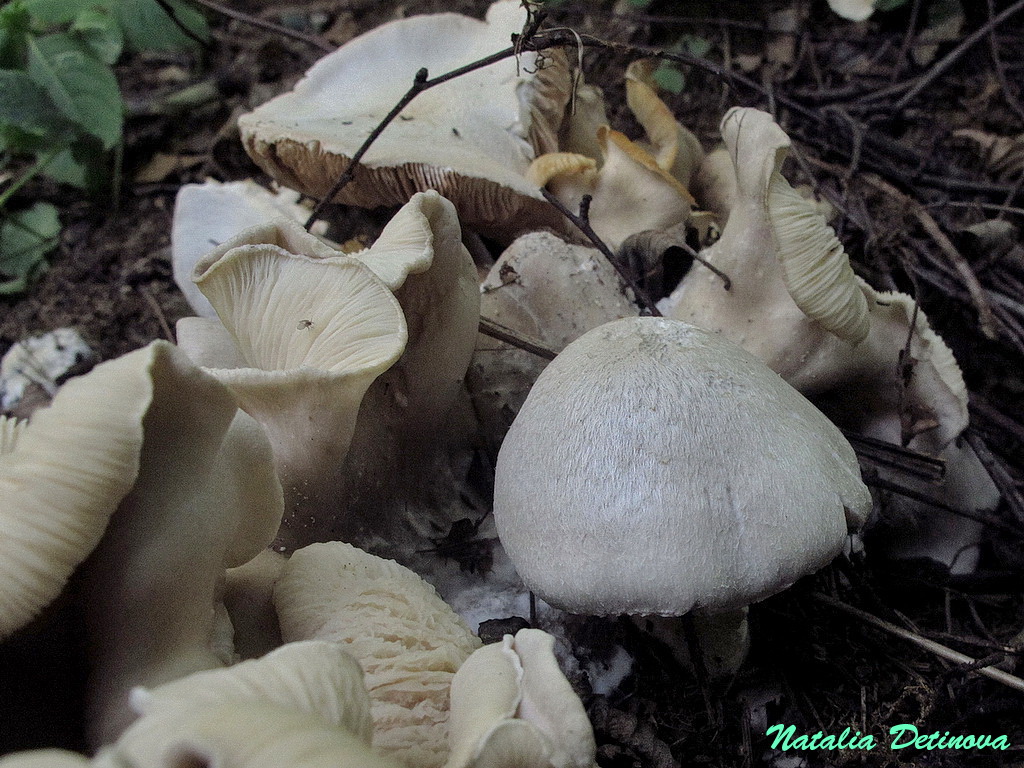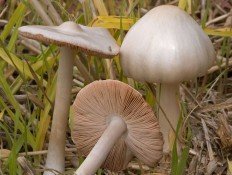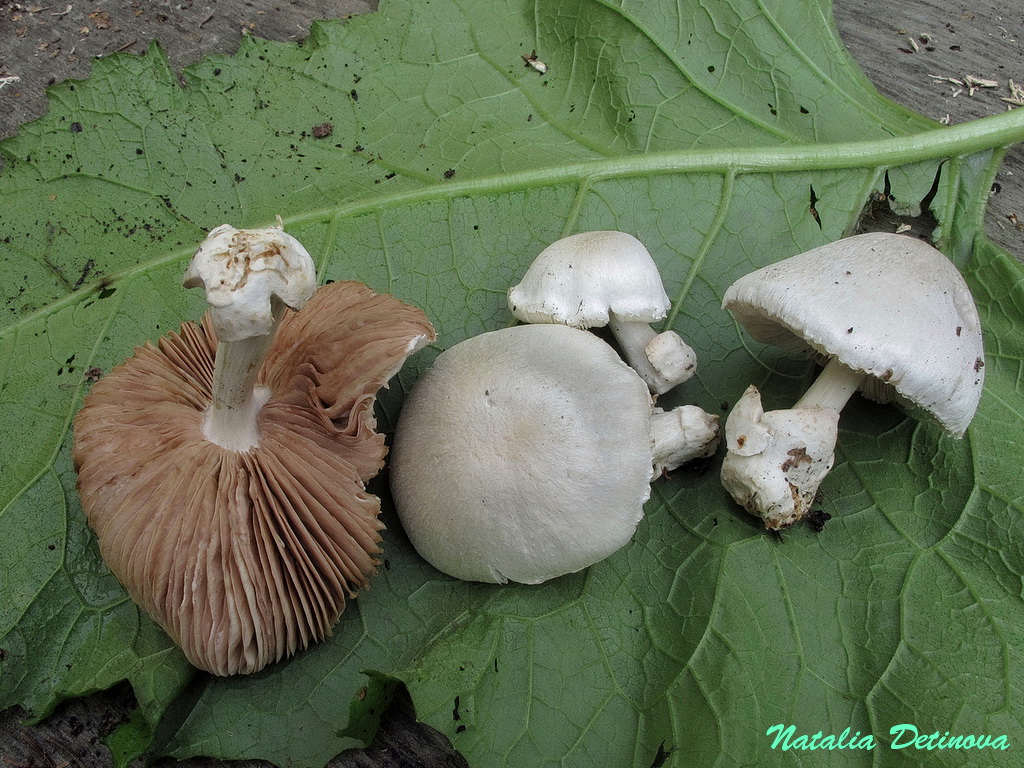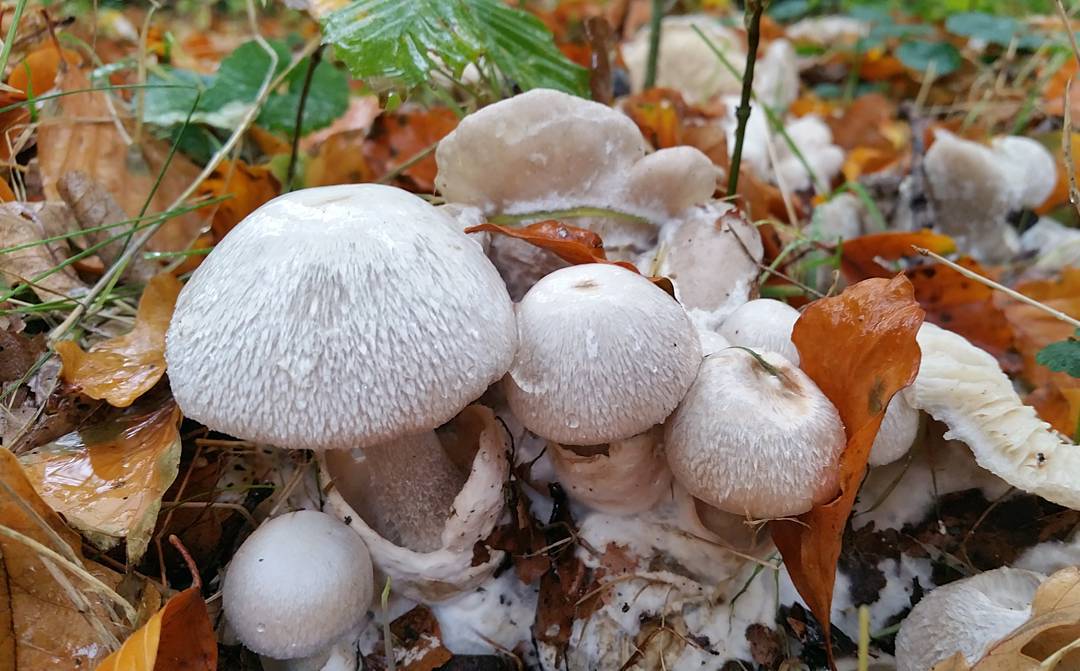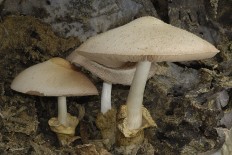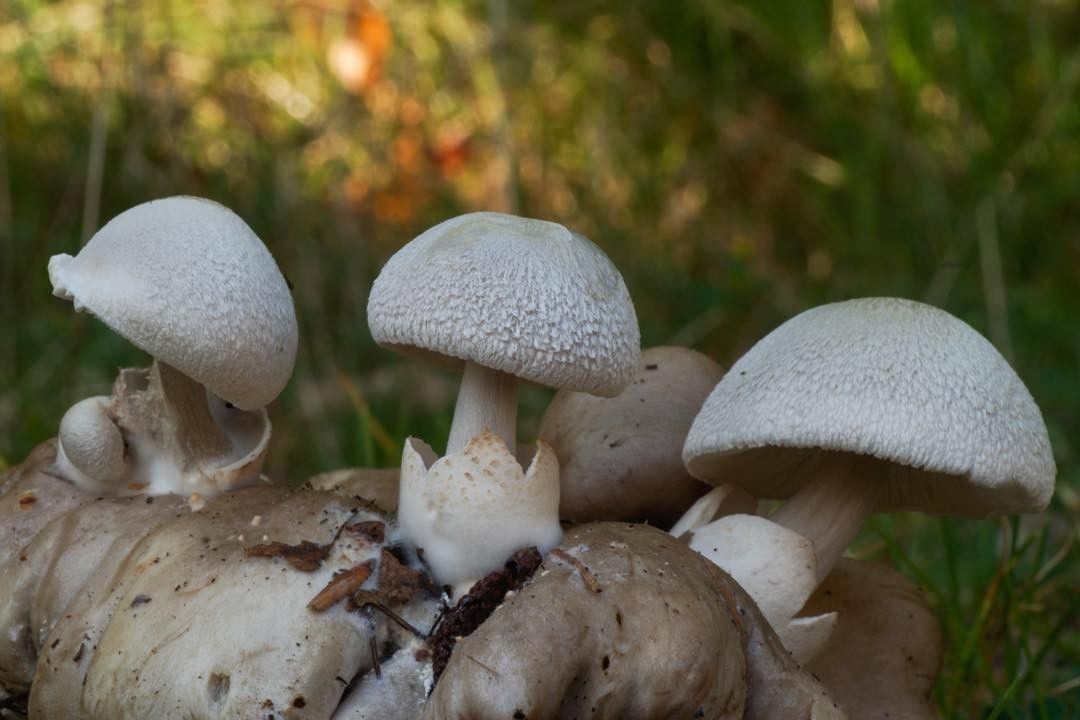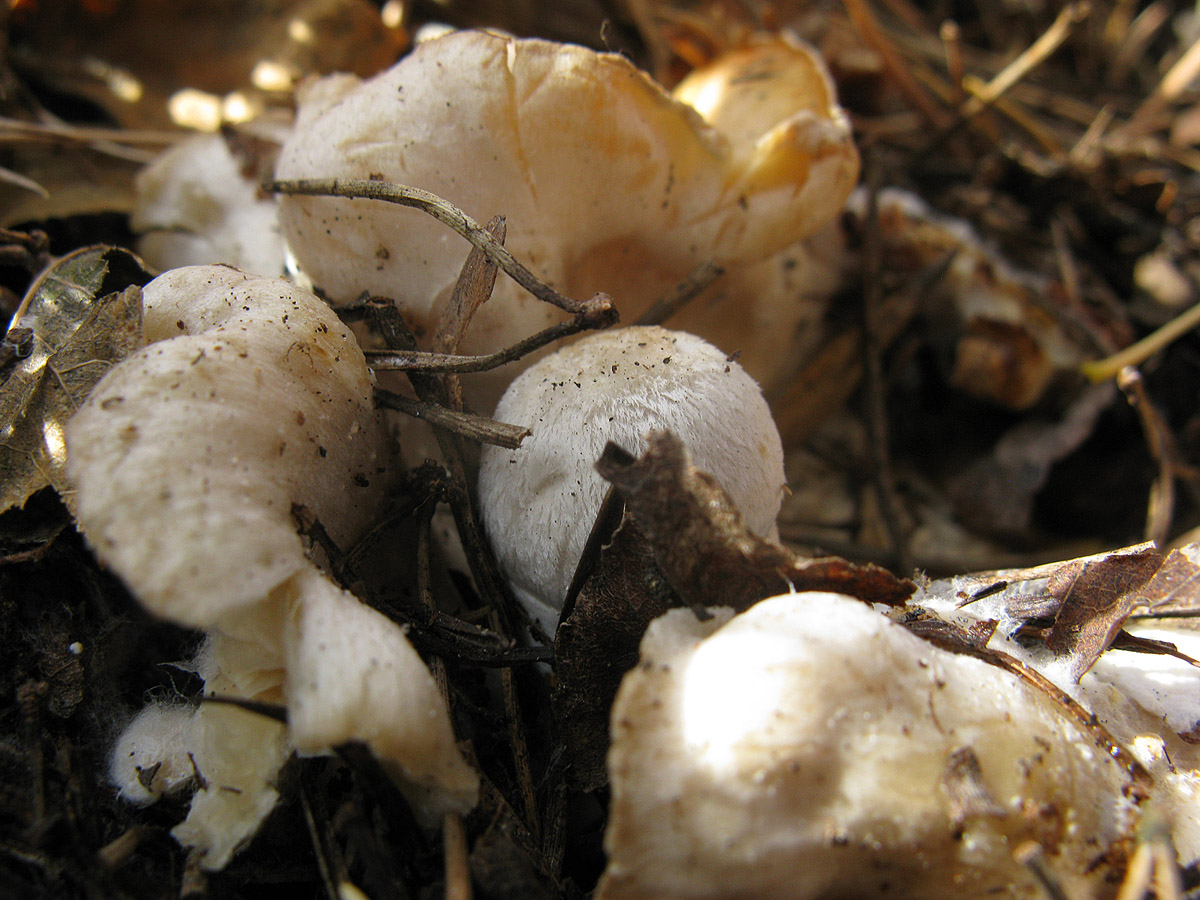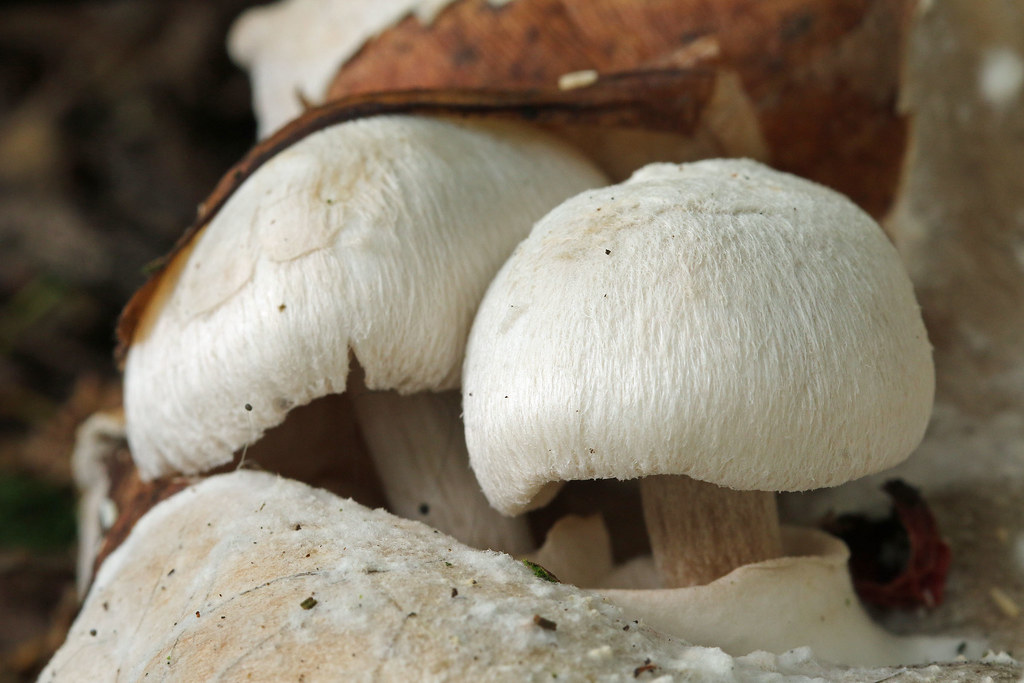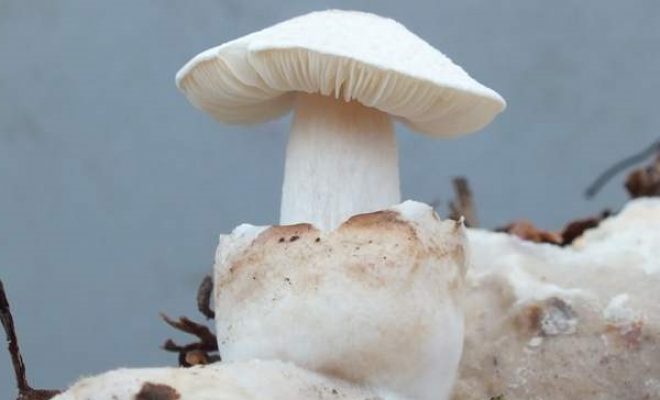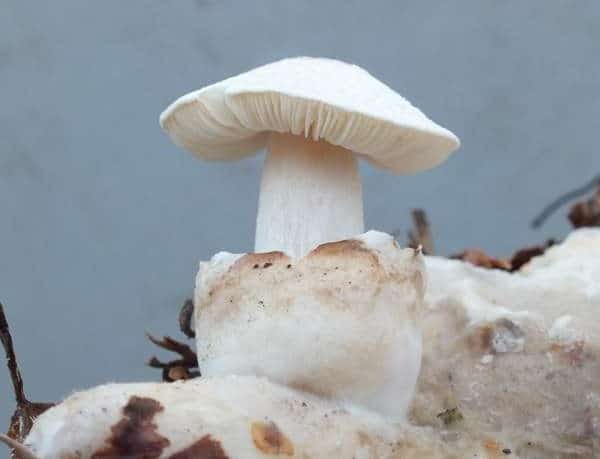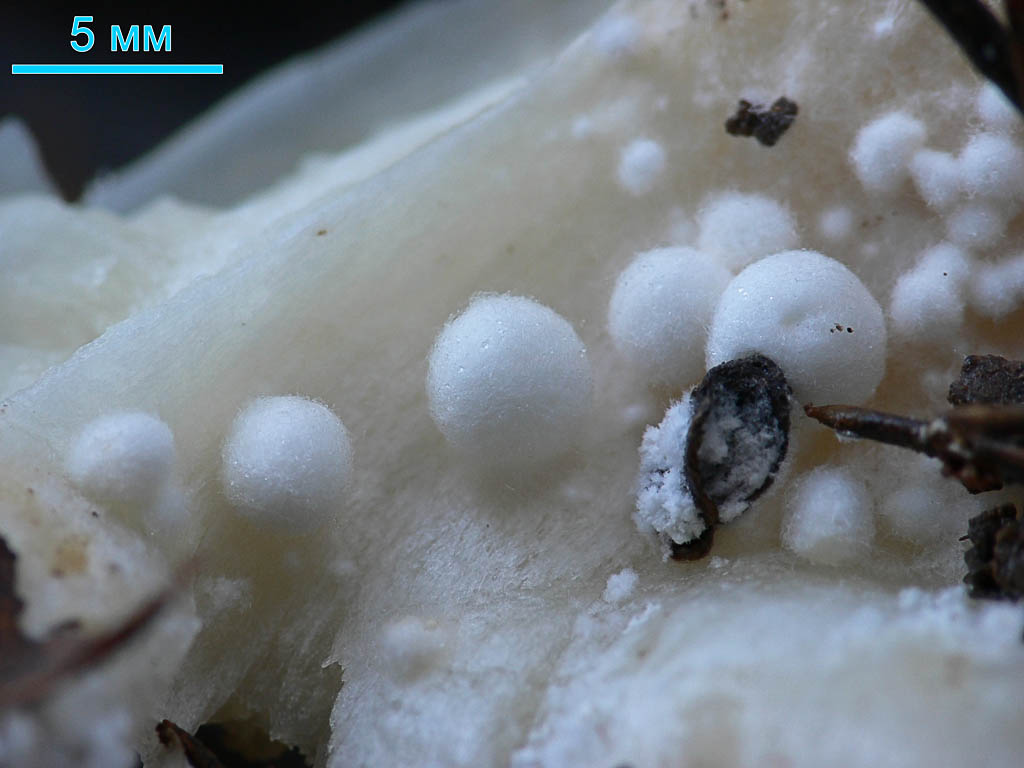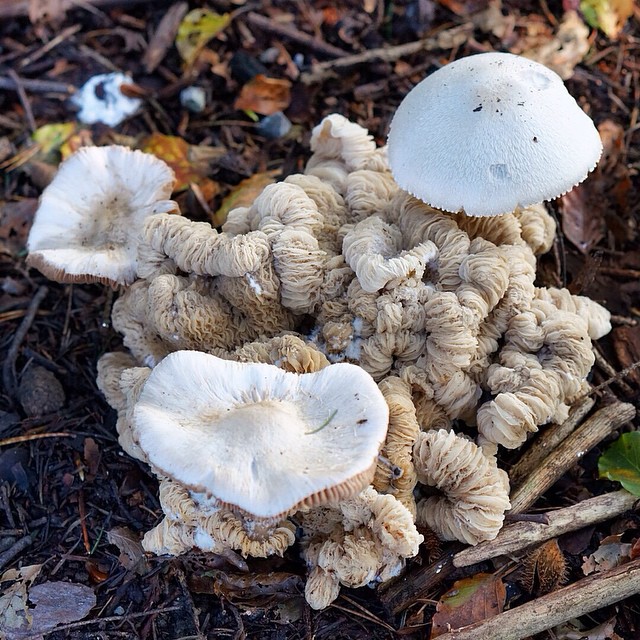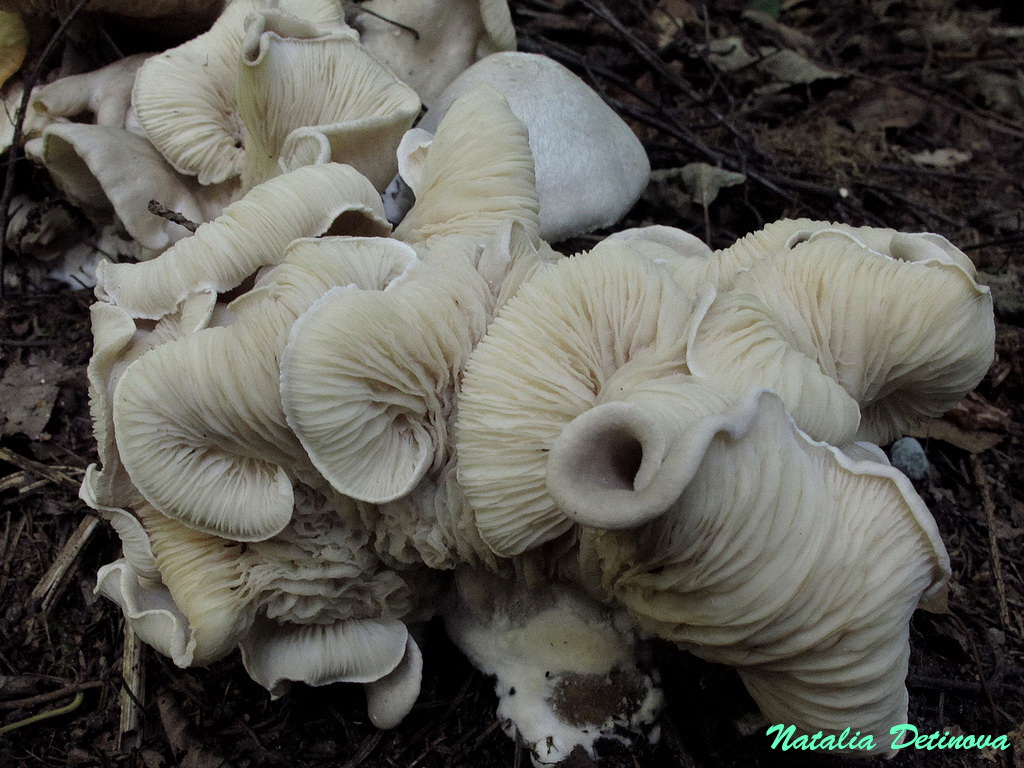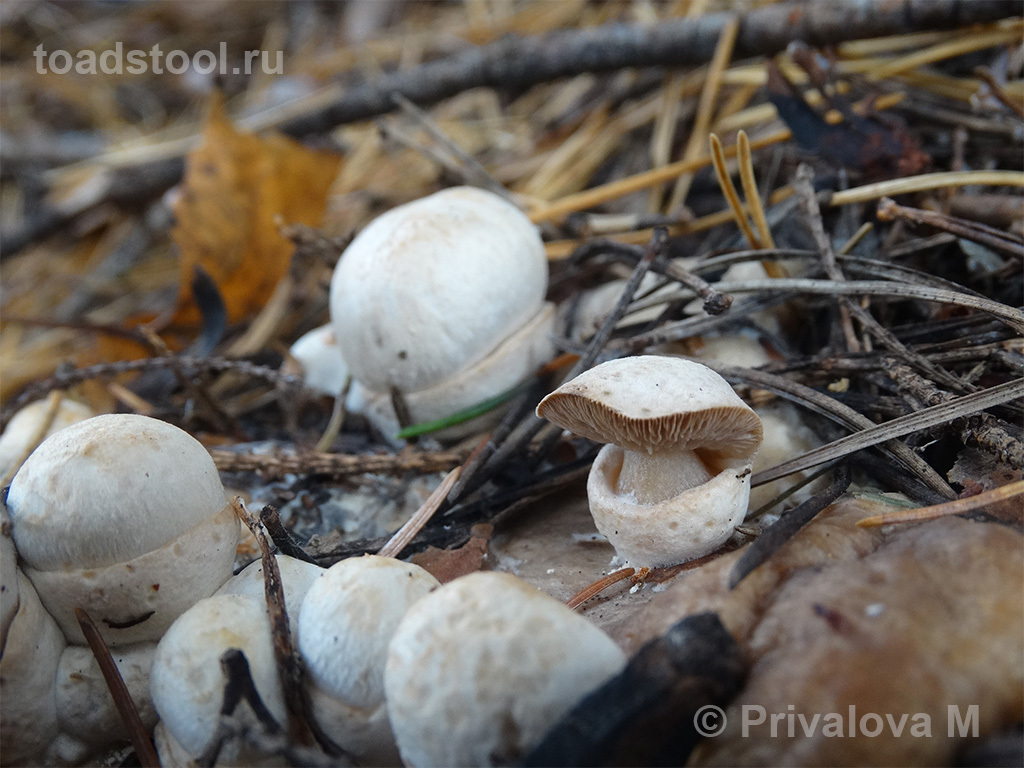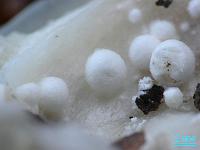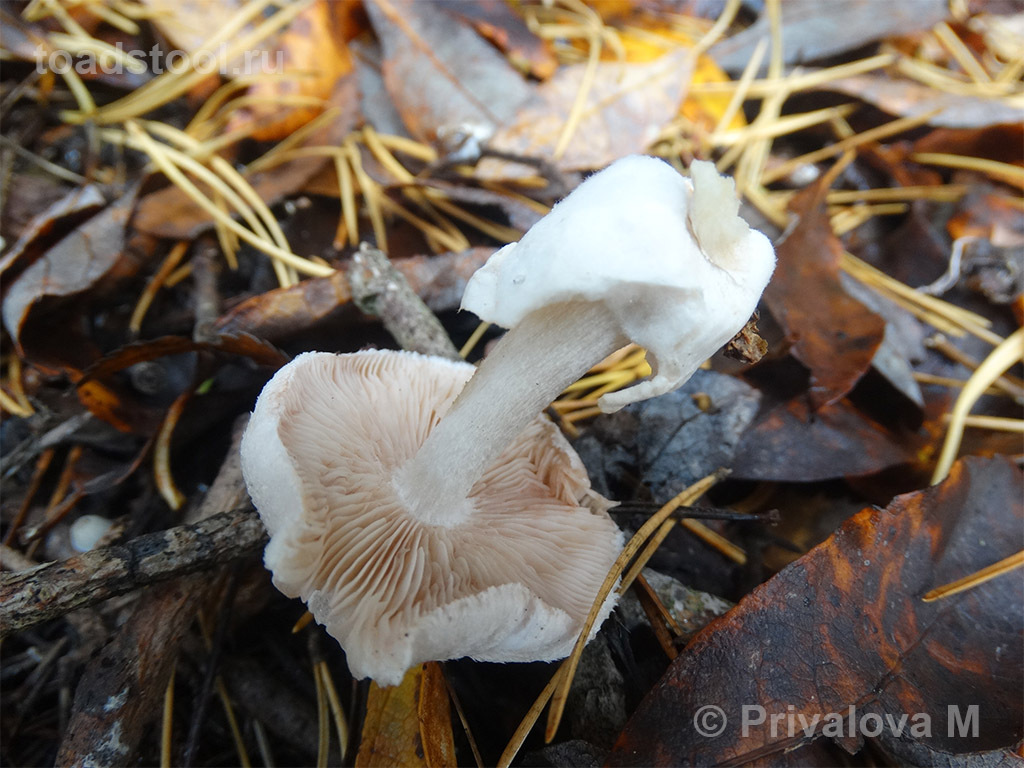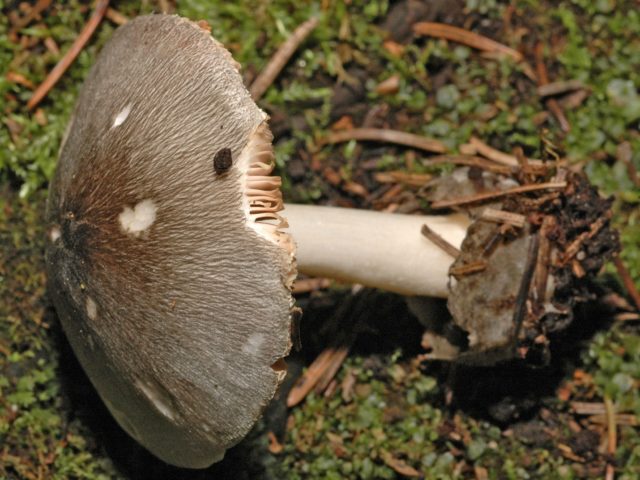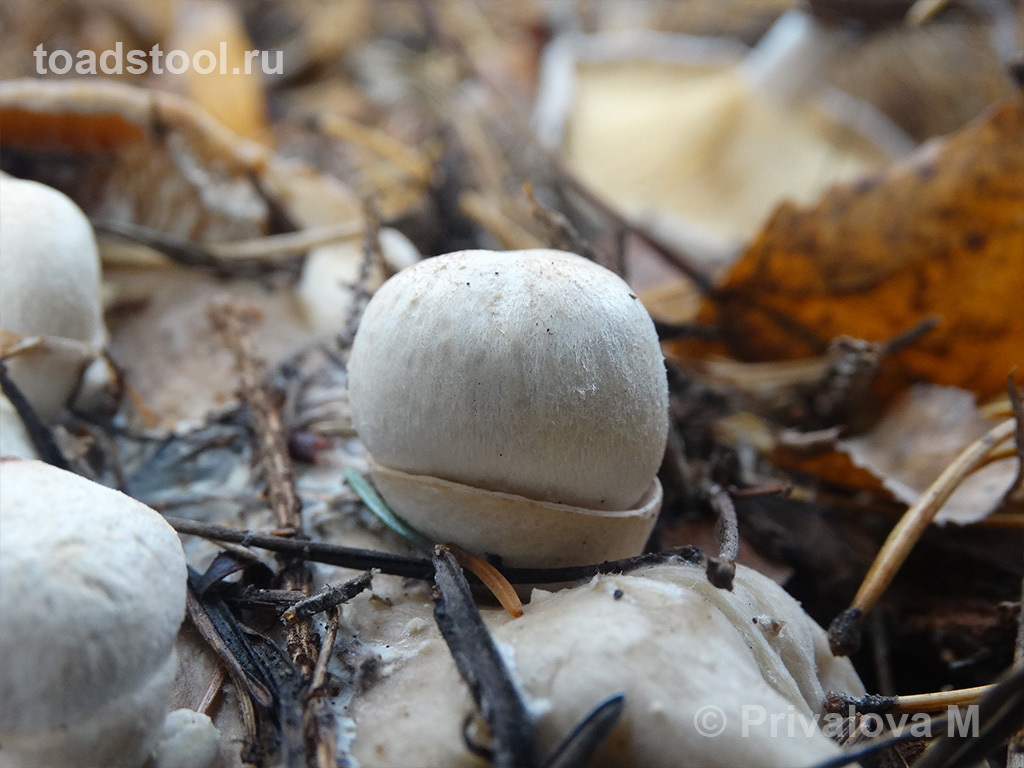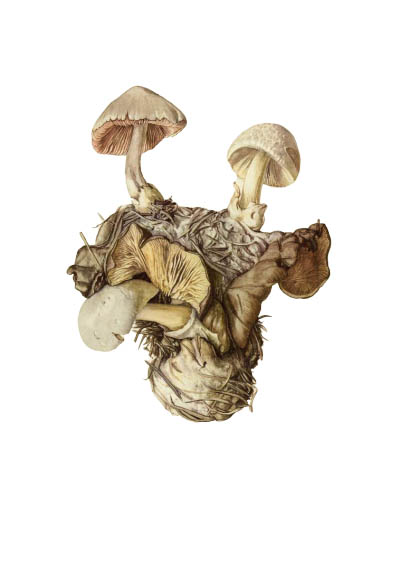Description of volvariella volvova
Volvo velvety volvariella hat. Its diameter is 4-12 centimeters. Its color is pale gray with a silvery tinge; over time, the cap fades and becomes almost white with pressed black fibers.

There are dark streaks on the cap, the top of the mushroom is more intensely colored. At a young age, the shape of the cap in the volvariella is a Volvo bell-shaped, and in adulthood it becomes prostrate.
The plates are loose, often spaced and soft. The color of the plates is whitish or white-pink. The pulp is dense, whitish in color. Spores are reddish or pink, ovoid-ellipsoidal, smooth. Dirty pink spore powder.
The stem is smooth, whitish, there are fibers on its surface. The length of the leg is 3-9 centimeters, and the thickness is 0.5-1.5 cm. The base of the leg is swollen, the tuber reaches 5 centimeters in diameter, the remnants of a whitish blanket are clearly visible on it. The leg is straight, central, cylindrical.
Areas of growth of volvariella volvova
These mushrooms grow in mixed forests and parks. They settle on the decaying remains of wood. Volvariella volvova bears fruit from summer to autumn. In our country, these mushrooms are common in the Amur Region, they can also be found in the city of Blagoveshchensk and the Primorsky Territory. In addition to Russia, they grow in Europe, Asia, North America and Africa. In Asia, volvariella volva is widespread.
Cultivation of volvariella volvova
Volvariella volvova is a type of edible mushroom grown in East and Southeast Asia. These mushrooms are widely used in Asian cuisine. Most often they are used in dried and canned form. Volvariella volvova is grown in rice straw beds.
Other mushrooms of this genus
Silky volvariella is a beautiful lamellar mushroom that grows on wood. The cap of the mushroom is bell-shaped, its diameter reaches 18 centimeters. The color of the cap is white at first, and eventually becomes pinkish. The leg is long, its base is thickened.
Silky volvariella is a rather rare mushroom. It grows in mixed forests and large parks. They settle on the trunks of weakened or diseased deciduous trees, preferring poplar, maple and willow. They bear fruit from July to August. In many countries, these mushrooms are very rare and included in the Red Book. These are edible mushrooms.
Volvariella mucosa, or mucous head, or beautiful, or beautiful - an edible, but low-value mushroom. It is the largest mushroom of the genus Volvariella. The diameter of the cap is 5-15 centimeters. The cap is smooth, whitish, rarely gray-brown and gray-white.
In the central part, the cap is darker in comparison with the edges, reaching a gray-brown color. At a young age, the caps are ovoid, and when the mushrooms grow up, the shape becomes bell-shaped with a fluffy edge, over time, the cap turns out completely, and a blunt tubercle remains in the center.
The stem of the mushroom is long and thin, its height is 5-20 centimeters, with a width of 1-2.5 centimeters. The stem is solid, cylindrical, with a tuberous base. The color of the leg is white or gray-yellow. At first, the leg is felt, but over time it becomes smooth.
Volvariella mucosa bears fruit from July to September. These mushrooms grow on humus soils, in landfills, garden beds, and in rare cases they are found in forests. They settle in small groups or singly.
Volvariella volvova is a popular food product in Southeast Asia.
Description
Volvariella was first cultivated in the 18th century in the Republic of China. This mushroom was presented to the emperor as a tribute. Today it is supplied from Indonesia, Madagascar, and the Philippines.In these countries, the mushroom is grown alternately with champignons: in the cool months - champignons, in the warm - volvariella.
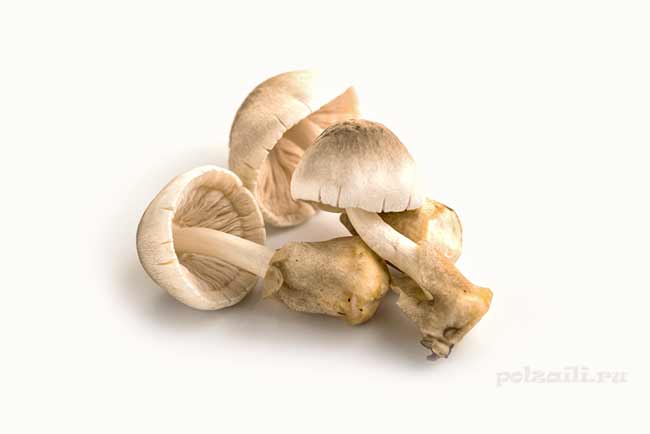
He is a member of the Pluteev family and belongs to the Agarik class. The genus Plutey combines small, medium and large species growing on trees, stumps, forest humus. In total, about 140 varieties are read, of which 30 are the genus Volvariella. A common feature of these is loose plates that turn pink with age.
The fungus is also known as volvariella bombicin. It has distinctive features:
- a bell-shaped cap up to 20 cm in diameter, there is a tubercle in the center, the color is whitish, yellowish-beige;
- the presence of scales;
- pinkish brown plates, frequent and wide;
- pink elliptical spores;
- long white leg, thickened at the base, reaches 18 cm in length, diameter - 1-2 cm;
- the pulp is light, after yellowish, thick and dense, has a pleasant mushroom smell.
The fungus is drought-resistant and tolerates heat up to 40 degrees above zero.
Definitioner
- Basidia (Basidia)
-
Lat. Basidia. A specialized structure of sexual reproduction in fungi, inherent only in Basidiomycetes. Basidia are terminal (end) elements of hyphae of various shapes and sizes, on which spores develop exogenously (outside).
Basidia are diverse in structure and method of attachment to hyphae.
According to the position relative to the axis of the hypha, to which they are attached, three types of basidia are distinguished:
Apical basidia are formed from the terminal cell of the hypha and are located parallel to its axis.
Pleurobasidia are formed from lateral processes and are located perpendicular to the axis of the hypha, which continues to grow and can form new processes with basidia.
Subasidia are formed from a lateral process, turned perpendicular to the axis of the hypha, which, after the formation of one basidium, stops its growth.
Based on morphology:
Holobasidia - unicellular basidia, not divided by septa (see Fig. A, D.).
Phragmobasidia are divided by transverse or vertical septa, usually into four cells (see Fig. B, C).
By type of development:
Heterobasidia consists of two parts - hypobasidia and epibasidia developing from it, with or without partitions (see Fig. C, B) (see Fig. D).
Homobasidia is not divided into hypo- and epibasidia and in all cases is considered holobasidia (Fig. A).
Basidia is the place of karyogamy, meiosis and the formation of basidiospores. Homobasidia, as a rule, is not functionally divided, and meiosis follows karyogamy in it. However, basidia can be divided into probasidia - the site of karyogamy and metabasidia - the site of meiosis. Probasidium is often a dormant spore, for example in rust fungi. In such cases, probazidia grows with metabasidia, in which meiosis occurs and on which basidiospores are formed (see Fig. E).

See Karyogamy, Meiosis, Gifa.
- Pileipellis
-
Lat. Pileipellis, skin - differentiated surface layer of the cap of agaricoid basidiomycetes. The structure of the skin in most cases differs from the inner flesh of the cap and may have a different structure. The structural features of pileipellis are often used as diagnostic features in descriptions of fungi species.
According to their structure, they are divided into four main types: cutis, trichoderma, hymeniderma and epithelium.
See Agaricoid fungi, Basidiomycete, Cutis, Trichoderma, Gimeniderm, Epithelium.
- Ixokutis
-
Cutis, consisting of hyphae immersed in mucus. The surface of the cap is oily, slippery or slimy.
Lat. Ixocutis.
See Cutis, Gifa.
Volvariella silky (Volvariella bombycina)
Synonyms:
Volvariella Bombicin
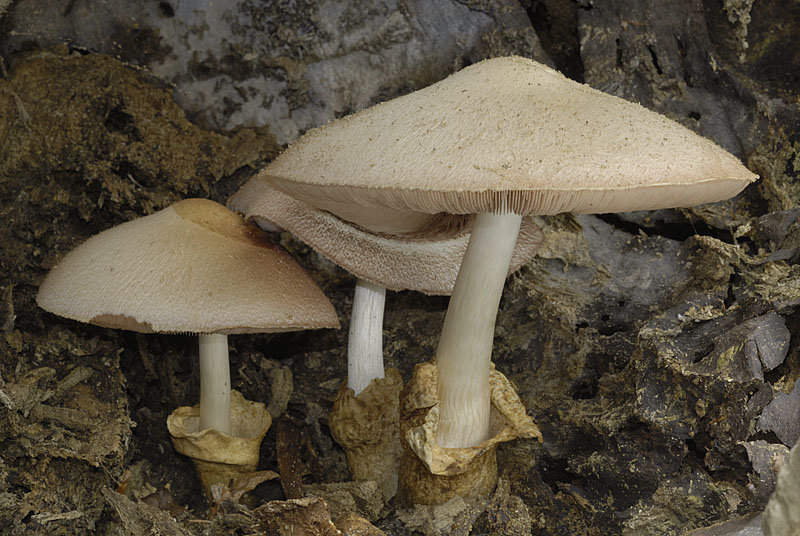
Volvariella silky or Volvariella bombycina (Latin Volvariella bombycina) is the most beautiful lamellar fungus growing on wood. The mushroom got its name due to the fact that mushrooms of this genus are covered with a kind of veil - volva. Among mushroom pickers, it is considered an edible mushroom, which is quite rare.
The mushroom is decorated with a bell-shaped scaly cap, reaching a diameter of eighteen centimeters. The plate of the mushroom becomes pinkish brown over time. The long stem of the mushroom at the base is significantly enlarged. Elliptical spores are pink in color. The lamellar layer of the fungus in the process of growth changes color from white to pinkish.
Silky volvariella is rare for mushroom pickers. It is common in mixed forests and large natural parks. A favorite place for settlement chooses dead and weakened by diseases trunks of deciduous trees. Of the trees, preference is given to maple, willow and poplar. The period of active fruiting lasts from early July to late August.
Due to the color and fibrous structure of the cap, this mushroom is very difficult to confuse with other mushrooms. He has a very peculiar look.
Volvariela is suitable for fresh consumption after boiling. The broth is drained after cooking.
In many countries, this rather rare species of fungus is included in the Red Data Books and in the lists of fungi protected from complete destruction.
The mushroom is known to professional mushroom pickers, but little known to inexperienced mushroom pickers and ordinary mushroom pickers, as it comes across quite rarely.
Some types of volvariela can be cultivated artificially, allowing you to get a good harvest of this type of delicious mushroom.
Mushroom photo Volvariella silky from questions in recognition:
Volvariella volvova - mushroom of the Plute family, genus Volvariella
It is an edible mushroom but must be picked with care as it can be confused with mushrooms of the genus Amanita.
Morphology
Fruit bodies caps are small to medium-sized, central or eccentric. The development types are bulbangiocarpous and pileocarpous.
Hat correct, initially bell-shaped or hemispherical, opens to convex or umbellate, there may be a central tubercle, easily detached from the pedicle. The surface is dry or slimy, smooth, fibrous or silky, white or colored.
Pulp from white to creamy yellow, usually does not change on the cut, sometimes it is slightly colored, the smell is not expressed or pleasant, mushroom.
Lamellar hymenophore, the plates are free, at first white, then from pink to brownish or brownish-pink.
Leg cylindrical, even, at the base may have a tuberous expansion, heterogeneous, executed. The surface is bare or pubescent
Remains of bedspreads: there is no ring, young mushrooms are completely covered with a common blanket, then it breaks, leaving a clearly visible saccular volva and scraps on the cap, which are easily separated from the surface and quickly disappear.
Spore powder from pink to brownish pink, disputes ellipsoid, less often ovoid, smooth, non-amyloid, cyanophilic. The color of the spores can vary depending on the age of the fungus, from straw yellow to pink.
Trama plates of an inverse structure, there are numerous pleuro- and cheilocystids of various shapes.
Hyphae without buckles.
Benefits of Volvariella Silky
Silky volvariella has a number of unique properties, because of which it began to be cultivated.
Firstly, freshly cut mushrooms contain up to 200 mg of vitamin C, at a rate of up to 100 mg for an adult. That is, only 50 grams of mushrooms is enough for an adult to satisfy the body's needs.
Secondly, the low calorie content and high nutritional value of volvariella is a great reason to include it in your diet for those who are watching their diet and want to lose weight. A small amount of mushrooms in the diet will help get rid of edema, remove toxins and toxins from the body. It will be useful for vegetarians to know that mushrooms are rich in healthy proteins, and it is useful to use them, so that there is no protein deficiency in the body.
Thirdly, these mushrooms are used in alternative medicine for the prevention and treatment of certain types of cancer: melanoma, carcinoma and sarcoma. In combination with traditional drugs, after chemotherapy, it gives an effective result in the fight against the disease.
Possible harm and contraindications
Like all mushrooms, volvariella has some collection features, non-observance of which can harm health.
It is necessary to pick mushrooms in an ecologically clean area. Since mushrooms do not have their own excretory system, they accumulate in themselves everything that the environment contains. Do not pick mushrooms near a busy road, in industrial areas, otherwise you can get poisoning with heavy metals, which usually contaminate the soil in such places.
If you are not sure that this is definitely a volvariella, such a mushroom should never be cut off, it may turn out to be poisonous.
At first, it is better to turn to experienced mushroom pickers. Which will show where and when it is better to collect a specific species, but it is better to take such a person with you, and clearly see everything.
Do not pick too large and old mushrooms, they can be harmful to health. Better to leave them so that they leave their disputes.
Never buy mushrooms off the hands of strangers. Even if it's just volvariella. It is not known where or when it was collected. Even if the mushrooms themselves were collected in a clean place and do not contain harmful impurities, their shelf life is very short, so they may not have any taste due to a long stay in the cut state.
The collected mushrooms must be washed thoroughly. There should be no dirt or dirt left on them.
It should also be remembered that mushrooms, despite all their benefits, are very heavy food for the body, so eating more than 300 grams per week is not recommended.
For the same reason, people with gastrointestinal disorders, children under 6 and older men and women should not eat mushrooms.
Benefits for the body
The mushroom has medicinal properties and is used in alternative medicine. It synthesizes substances with antioxidant effects. Polysaccharides from mycelial culture have anticancer activity and inhibit the growth of sarcoma, B 16 melanoma, Ehrlich's carcinoma.
A combination of medicines and mushrooms gives an effective result. Treatment with the gifts of nature is recommended after chemotherapy sessions. In any case, the therapeutic course should be monitored by the attending doctor.
The benefits of volvariella in the fight against obesity lie in its high nutritional value and low calorie content. In addition, small quantities of mushrooms improve digestion, normalize metabolism and help remove toxins from the body. It is recommended to consume no more than 300 g per week.
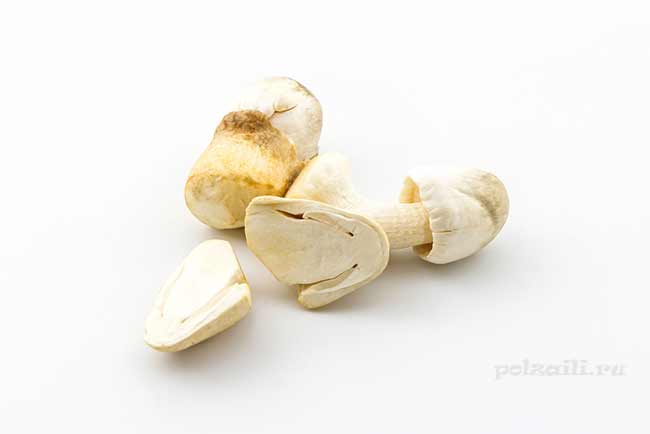
Growing Volvariella + video
In China, the cultivation of volvariella alternates with the cultivation of mushrooms. Volvariella is grown in the warm season, from April to October, mushrooms - in the cold.
Farmed volvariella are believed to have a more pronounced flavor than their wild counterparts.
In order to get a good harvest of mushrooms, it must be remembered that volvariella are very thermophilic mushrooms. In hot regions they can be grown outdoors, in temperate regions it is better to grow them in a heated room or in a greenhouse.
In China, they are grown on waste from cotton and rice production. The racks are filled with cotton substrate with a layer of 10 cm, then fermented rice straw with a layer of 15 cm. In Europe, these materials are difficult to get, so you can use compost or any good quality straw.
To get fermented straw, it is necessary to moisten it properly, put it in a stack 1 m in height. If necessary, moisten the upper layers additionally. Then the stack must be compressed. The desired state can be achieved in 4-5 days, after which the material can be used for growing mushrooms. A fifteen-centimeter layer of compost is placed in a box or rack, which is covered with ready-made straw.
The temperature of the substrate for grafting mycelium should be no higher than 35 degrees. As soon as the required temperature is reached, the mycelium is evenly distributed throughout the entire volume of the substrate.
Growth temperature 20-28 degrees Celsius, ideal humidity 85-92%. Growth does not occur at lower temperatures. Protect racks from direct sunlight. However, it should be remembered that insufficient illumination, as well as insufficient or excessive humidity, lead to a decrease in yield.
If all conditions are met, then in just two weeks, two weeks you can get the first fruits. If the temperature and humidity conditions are observed, then the mushrooms grow very actively.
For export, mushrooms are harvested immediately after the full disclosure of the Volvo, if the mushrooms are not for sale, then you can wait longer for the cap to open, and the mushroom itself has grown.
After 60 days, the substrate is already considered exhausted, and the yield period of the volvarielle mycelium has come to an end. Under favorable conditions in a warm climate, the yield reaches 80% of the weight of the substrate, but in central Russia, due to the colder climate, this figure is lower and reaches no more than 60%.
How to cook
Volvariella is a conditionally edible mushroom. Its taste cannot be called distinctive. The most delicious types of mushrooms are cultivated and obtained by an artificial method. In China, the cultivation method is used on straw from rice, in South Asia - on the waste of oil palm.
Before cooking, the mushroom is boiled for 30-40 minutes, and the water remaining after that is drained. They use hats for food, the legs are too hard. Those who are fortunate enough to try volvariella talk about the similarity of its taste to fried zucchini.
Mushroom julienne
The mushroom is used to prepare salads, soups, fillings for pies and pies. If you combine them with cheese and chicken, you get a delicious julienne.
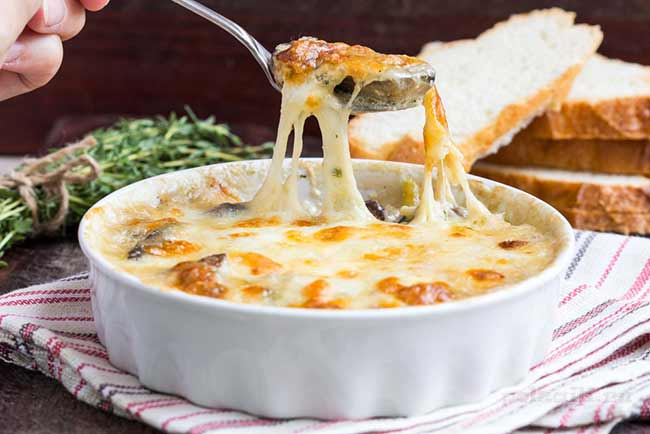
To prepare it you will need:
- 400 g chicken breast;
- 50 ml of vegetable oil;
- 3 onions;
- 150 g mayonnaise or sour cream;
- 200 g of hard cheese;
- 30 g butter;
- salt, spices;
- 600 g of lamellar mushrooms.
Preparation:
- Boil chicken breasts in salted water for 30-40 minutes, cut them into small square pieces.
- Peeled mushrooms are cut into slices.
- The onion is chopped in half rings.
- The cheese is chopped on a coarse grater.
- Oil is poured into a saucepan, mushrooms and onions are added.
- After the liquid has completely evaporated, the products are fried, salted, and seasoned with spices.
- Mushrooms, onions, chicken breasts are alternately spread in a special form. They are poured with mayonnaise and sprinkled with cheese.
The dish is kept in the oven for 25 minutes. Serve hot.
Areas of growth of silky volvariella.
This mushroom is quite rare for mushroom pickers. Volvariella silky grows in mixed forests, as well as large natural parks. These fungi inhabit weakened deciduous trees such as poplars, maples and willows. Volvariella silky actively bears fruit from the beginning of July to the end of August.
In many countries, volvariella silky is considered a fairly rare fungus. It is included in the Red Data Books of several countries and is in the lists of species protected by the state. This species is known to professionals, and inexperienced mushroom pickers know little about it, since it is rarely found. Volvariella never form dense aggregates, they occur singly.
The development process of volvariella silky.
The life of this fungus begins from the "egg" stage. In this state, the silky volvariella is enclosed in a common veil. If you cut a mushroom, you can see a mushroom embryo inside.
Then a mushroom begins to emerge from the egg, and it rolls around in all its glory. At first, his hat is bell-shaped, and later it straightens, while the leg remains wrapped in the remains of the bedspread.
In old age, the silky volvariella becomes less attractive - the caps become bald, flabby and wrinkled, and the dazzling whiteness disappears.
The similarity of volvariella silky with other mushrooms.
Due to its color, the silky volvariella has no resemblance to other species, in addition, it has a fibrous structure. She looks very peculiar.
Evaluation of the taste of volvariella silky.
Mushroom pickers consider volvariella edible. In general, volvariella mushrooms are quite small, our heroine is the largest species. Before cooking, the mushrooms are boiled, and the broth is drained.
Growing volvariella.
Volvariella are edible, but their taste is not exceptional. However, some types of volvariella are even cultivated and artificially harvested delicious mushrooms. The only tasty species is considered to be volvariella, which is grown on wood waste or on rice straw.
Related species.
Volvariella mucous head is a conditionally edible mushroom. The cap varies from ovoid to convex-outstretched with a blunt wide tubercle in the center. Her color is white-gray or gray-brown. In wet weather, its surface is slimy. The mushroom pulp is loose and thin, its smell and taste are not expressed. The leg is long and thin, white or gray-yellow in color.
These volvariella settle not on trees, but on soil, and on humus, for example, it can be found on compost heaps, on stubble, in beds, and the like, and this species is rarely found in the forest. Fruiting of the mucoushead volvariella occurs from July to September. Fruit bodies appear singly or in small groups.
The parasitic volvariella is an inedible relative of the silky volvariella. Her hat is thin, at first spherical, and then flat. The skin is dry, covered with fluff. The color of the cap can be off-white or brownish. The leg is strong, with a silky surface. The pulp is spongy, with a sweetish taste and pleasant smell.
Volvariels of this species settle on the remains of other fungi. Sometimes parasitic volvariella are found in numerous colonies. They grow in summer.
| Volvariella mucous head | ||||||||||||||||||||||
| Volvariella mucous head (Volvariella gloiocephala) | ||||||||||||||||||||||
| Scientific classification | ||||||||||||||||||||||
|---|---|---|---|---|---|---|---|---|---|---|---|---|---|---|---|---|---|---|---|---|---|---|
intermediate ranks
|
||||||||||||||||||||||
| International scientific name | ||||||||||||||||||||||
|
Volvariella gloiocephala(DC.) Boekhout & Enderle, 1986 |
||||||||||||||||||||||
| Synonyms | ||||||||||||||||||||||
|
Volvariella mucous head (lat.Volvariella gloiocephala) - a mushroom of the genus Volvariella of the family Pluteaceae (Pluteaceae).
Synonyms:
- Russians: volvariella slimy, volvariella fine, volvariella viscous hat
- Latin:
- Volvariella gloiocephala (DC.) Boekh. & Enderle, 1986basionym
- Volvaria speciosa (Fr.) Gillet 1876
- Volvariopsis gloiocephala (DC.) Murrill, 1917
- Agaricus gloiocephalus (DC., 1815
- Agaricus emendatior (Berk. & M.A. Curtis, 1859
- Agaricus pubescens Schumach., 1815
- Amanita speciosaFr., 1951
- Agaricus speciosus Fr., 1821
- Pluteus speciosus Fr., 1836
Some sources distinguish light-colored forms like Volvariella speciosa (Fr.) Singer, 1951 and darker ones like Volvariella gloiocephala (DC.) Boekh. & Enderle, 1986
Volvariella mucous (Volvariella gloiocephala)
- Other names for the mushroom:
- Volvariella mucous head
- Volvariella is beautiful
- Volvariella viscous hat
Synonyms:

This mushroom belongs to the genus Volvariella, the Pluteaceae family.
Often it is also called mucous volvariella, fine volvariella or viscous-cap volvariella.
Some sources distinguish two types of forms of this fungus: light-colored forms - Volvariella speciosa and darker - Volvariella gloiocephala.
Volvariella mucosa is a low-value edible or conditionally edible mushroom of average quality. It is used in food almost fresh, after only 15 minutes of boiling.
This mushroom is the largest of all the soil-living species of the genus Volvariella.
The cap of this mushroom has a diameter of 5 to 15 cm. It is smooth, whitish, less often it is grayish-whitish or grayish-brown in color.In the middle, the cap is darker than at the edges, gray-brown in color.
In younger mushrooms, the cap has an ovoid shape, enclosed in a common shell called a volva. Later, when the mushroom grows up, the cap becomes bell-shaped, with a lowered edge. Then the hat turns out completely, becomes convex-outstretched, having a wide obtuse tubercle in the center.
In wet or rainy weather, the mushroom cap is slimy, sticky, and in dry weather, on the contrary, it is silky and shiny.
The flesh of volvariella is white, thin and friable, and, if cut off, it does not change its color.
The taste and smell of the mushroom are inexpressive.
The plates are from 8 to 12 mm wide, rather wide and frequent, and at the foot they are free, at the edge they have a rounded shape. The color of the plates is white; as the spores mature, it acquires a pinkish tint, and later they become completely brownish-pink in color.
The stem of the mushroom is thin and long, its length varies from 5 to 20 cm, and its thickness can be from 1 to 2.5 cm. The shape of the stem is cylindrical, solid, and somewhat tuberous thickened at the base. It is found in color from white to gray-yellow.
In younger mushrooms, the leg is felt, later it becomes smooth.
The mushroom does not have a ring, but the Volvo is free, has a bag-like shape and is often pressed against the leg. It is thin, has a whitish or grayish tint.
Spore powder of pink color, the shape of the spores is short-ellipsoidal. Spores are smooth, light pink in color.
It occurs from the beginning of July to the end of September, mainly on disturbed humus soils, for example, on stubble, garbage, manure and compost heaps, as well as on garden beds, landfills, in the bases of haystacks.
This mushroom is rarely found in the forest. The mushrooms themselves appear singly or are found in small groups.
This mushroom is similar to such a conditionally edible mushroom as a gray float, as well as poisonous fly agarics, which are white. Volvariella differs from the float in the presence of a smooth and silky leg, and also has a sticky grayish cap with pinkish plates. It can be distinguished from poisonous fly agarics by its pinkish hymenophore and the absence of a ring on the leg.

